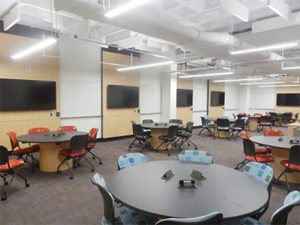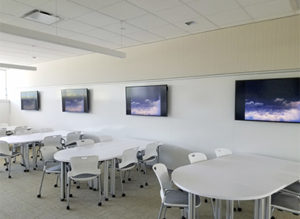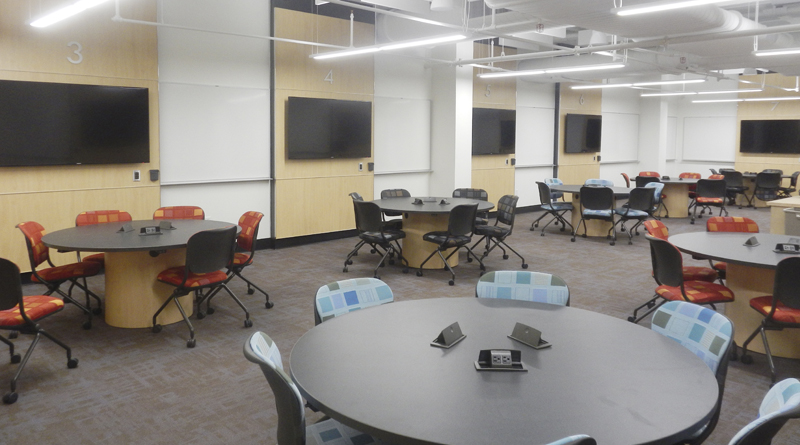Flipped Classrooms Change Student Learning
By David A. Bateman, Jr.
Listen to the lecture at home, do your homework in class. It may seem counter to what some of us grew up doing, but it has become commonplace for today’s student learning. Traditionally, students learn new information through lecture or direct instruction while in school. In flipped classrooms, students study the lecture at home, and class time is spent discussing, experimenting and exploring those topics in greater depth. Since around 2000, the upside-down or flipped classroom model has seen more acceptance and adaptation, and gained more mainstream media attention. However, that is only part of the story.

Advancements in personal computing have pushed the envelope on not only what students learn, but how. The terms “active learning classroom” and “team-based learning” describe a pedagogy in which students are actively engaged in the learning process. Similar to the flipped model, these approaches involve students working together in class to advance what they learned at home. They are working in teams to solve a problem or developing a solution to an issue by collaborating with the teacher as well as their peers. With or without technology in the classroom, this model has shown to improve learning outcomes.
New Solutions
By adding technology to these models, so-called “TEAL” or “SCALE-UP” solutions have become prevalent in the classroom.
TEAL, developed at MIT in 2004 as Technology Enabled Active Learning (or Technology Enhanced Active Learning), involves a new classroom setup by removing the front lectern, placing the instructor in the middle of the class, and locating a video projector, flat screen displays and white boards around the room’s perimeter. Small groups of students work together and help each other through the curriculum. The technology connection provides immediate access to online resources. In addition, the instructor has the flexibility to refocus individual groups, while allowing others to continue working without interruption.
The Student-Centered Active Learning Environment with Upside-down Pedagogies model, known as SCALE-UP, is another name for the same classroom layout, with an included description on the teaching style.
Unique Classroom Design
There is a great deal of similarity in how these classrooms are laid out. Typically, tables of six to eight students are spread around the room with a teacher station centrally located. Display devices are hung from the walls, usually one per table as space allows. With the cost of flat-panel displays continuing to drop, these seem to be more prevalent than video projectors and projection screens.

Photo Credit (all): Courtesy of Acentech
The next factor is connection. Students need to be able to connect their device to the display to show work, as well as connect the device to the network. Current estimates indicate that by 2020, each student will have six wireless devices. That proliferation of personal technology requires the school’s wireless infrastructure to provide sufficient coverage and bandwidth.
Once the network bandwidth solution is addressed, connecting student devices to the displays in the classroom is the next critical element to the “technology enhanced” portion of learning.
Students can connect via a wired connection between their device’s (laptop/tablet) video output and the input to the display. This requires that there is a connection plate either under the display or through a floor box under their table. In a SCALE-UP classroom with 12 tables, that can be a lot of floor boxes or poke-through devices, which almost certainly give the structural engineer some pause. That scenario also limits the ability to move tables into different configurations.
The other connection option is to connect the device wirelessly. There are a number of solutions that allow students to connect to the AV system and show content, regardless of the device type. A number of wireless receiver solutions also allow multiple students to connect simultaneously, which is exactly what the TEAL classroom is designed for: Group learning with technology enhancements.
Another important design factor is how interior finishes and background noise levels need to be carefully programmed to account for groups of students working simultaneously. Absorptive finishes to help mitigate noise might be necessary. In addition, wall construction between adjacent active learning classrooms will need to be addressed to limit sound transfer. Finally, HVAC noise within the classroom needs to be quiet enough to allow instructors to be heard by students.
When each of these factors is taken into account, students can collaborate, teachers can interact easily with student groups, technology can run smoothly, and learning can take on a whole new meaning.
David A. Bateman, Jr. is a principal at Boston-headquartered Acentech, a multi-disciplinary acoustics, audiovisual systems design and vibration-consulting firm.
This article was originally published in its entirety in the November/December issue of School Construction News, available now.

